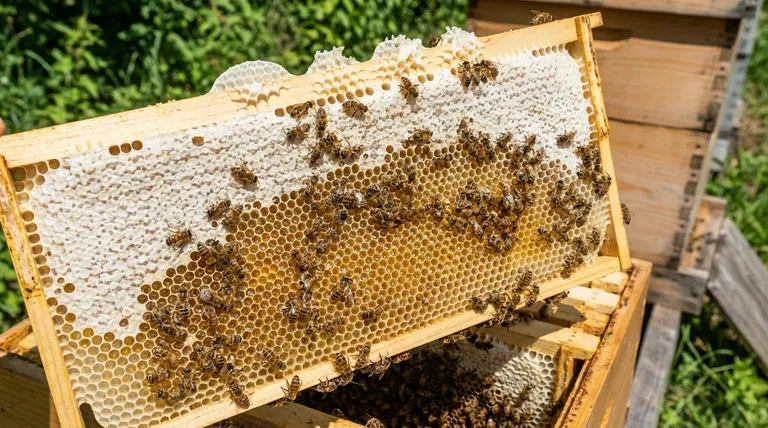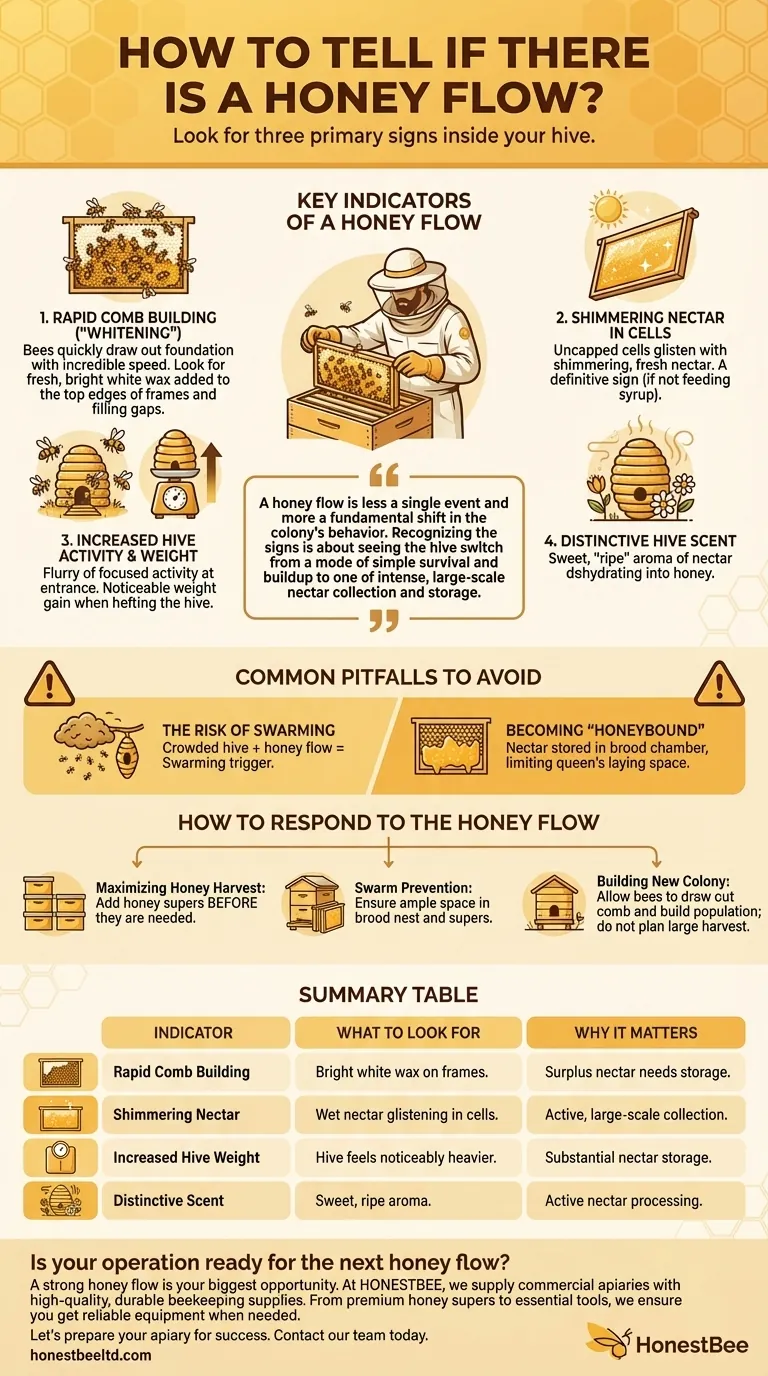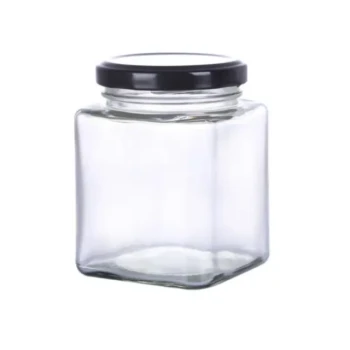To determine if a honey flow is on, look for three primary signs inside your hive. You will see bees rapidly building new, white wax comb, find cells glistening with fresh, wet nectar (assuming you aren't feeding them sugar syrup), and notice this bright white wax being added to the tops of frames.
A honey flow is less a single event and more a fundamental shift in the colony's behavior. Recognizing the signs is about seeing the hive switch from a mode of simple survival and buildup to one of intense, large-scale nectar collection and storage.

Understanding the Honey Flow
A honey flow is a period when one or more major floral sources are producing so much nectar that the local bee colonies can collect a surplus. This is the time when bees create the honey that beekeepers can harvest.
It is not a constant state. Instead, it is a seasonal peak tied to the blooming of specific, high-yield plants like clover, basswood, or goldenrod, depending on your region.
Key Indicators of a Honey Flow
Observing your hive's internal activity is the most reliable way to confirm a flow has begun.
Indicator 1: Rapid Comb Building ("Whitening")
When a massive amount of nectar comes into the hive, the bees' primary problem becomes storage space. This triggers their wax glands to work overtime.
You will see them drawing out foundation on new frames with incredible speed. A key sign is "whitening," where bees add fresh, bright white wax to the top edges of frames and to fill any gaps.
Indicator 2: Shimmering Nectar in Cells
During a strong flow, bees place nectar in open cells faster than they can cure it. When you pull a frame from a super, you will see cells that are not yet capped.
If you tilt this frame in the sunlight, you will see a shimmering liquid inside. This is fresh, uncured nectar with high water content. This is a definitive sign, but only if you have stopped feeding the colony sugar syrup.
Indicator 3: Increased Hive Activity and Weight
The entire hive's tempo changes. The entrance will be a flurry of focused activity, with foragers flying purposefully in and out, rather than milling about.
The hive itself will gain weight noticeably. An experienced beekeeper can often feel this change by simply hefting the back of the hive a few inches off its stand.
Indicator ika-4: A Distinctive Hive Scent
A hive that is processing a large volume of nectar has a unique and pleasant smell. Standing near the hive, you may notice a sweet, "ripe" aroma, which is the smell of nectar being dehydrated into honey.
Common Pitfalls to Avoid
Recognizing the honey flow is only the first step. Failing to act on these signals can compromise both your honey harvest and the health of your colony.
The Risk of Swarming
A strong honey flow combined with a crowded hive is the most common trigger for swarming. The influx of resources and a lack of space for the queen to lay eggs tells the colony it's time to divide.
Becoming "Honeybound"
If you don't provide extra boxes (supers) for nectar storage, the bees will begin storing it in the brood chamber. This is known as becoming honeybound.
This fills cells that the queen needs for laying eggs, which can severely restrict the colony's population growth and weaken it for the periods after the flow.
How to Respond to the Honey Flow
Your actions during the flow should align with your beekeeping goals for that specific colony.
- If your primary focus is maximizing honey harvest: Add honey supers before the bees need them to ensure they never run out of storage space.
- If your primary focus is swarm prevention: Ensure the colony has ample space in both the brood nest and the honey supers to accommodate the boom in resources and population.
- If your primary focus is building up a new colony: Allow the bees to use the flow to draw out comb and build their population, and do not plan on taking a large honey harvest.
Understanding these signals allows you to work in partnership with your bees, ensuring they have the resources they need to thrive.
Summary Table:
| Indicator | What to Look For | Why It Matters |
|---|---|---|
| Rapid Comb Building | Bees quickly drawing out bright white wax on new frames and tops of frames. | Signals a surplus of nectar that needs immediate storage space. |
| Shimmering Nectar | Uncured, wet nectar glistening in open cells when you tilt a frame in the sun. | Confirms active, large-scale nectar collection (if not being fed syrup). |
| Increased Hive Weight | The hive becomes noticeably heavier when you gently heft it from the back. | Direct evidence of substantial nectar being stored. |
| Distinctive Hive Scent | A sweet, ripe aroma around the hive from nectar being dehydrated into honey. | Indicates the colony is actively processing a large nectar influx. |
Is your operation ready for the next honey flow?
A strong honey flow is your biggest opportunity for the season, but it requires the right equipment and strategy to maximize your harvest and prevent swarming. At HONESTBEE, we supply commercial apiaries and distributors with the high-quality, durable beekeeping supplies needed to capitalize on these critical periods.
From premium honey supers and frames to essential hive tools, our wholesale-focused operations ensure you get the reliable equipment you need, when you need it.
Let's prepare your apiary for success. Contact our team today to discuss your specific needs and how we can support your growth and profitability.
Visual Guide

Related Products
- Precision Honey Refractometer Instrument for Quality Assessment
- HONESTBEE 15-in-1 Beekeeper Multi-Tool with Hammer and Pliers for Beekeeping
- Plastic Honey Gate Spout with Wing Nut for Beekeeping Honey Bucket
- Inverted Squeezable Honey Jar with No Drip Flip Top Cap for Easy Pouring
- Stainless Steel Manual Honey Press with Guard for Pressing Honey and Wax
People Also Ask
- How does a honey refractometer work? Ensure Honey Quality & Harvest Readiness
- Why is a honey refractometer important for beekeepers? Ensure Quality and Prevent Fermentation
- What is a honey refractometer and what is its purpose? Ensure Honey Quality and Prevent Spoilage
- What are the key points for proper usage of a honey refractometer? Ensure Accurate Moisture Readings Every Time
- What are the benefits of using a Pocket Digital Honey Refractometer? Achieve Precision & Speed in Honey Quality Control



















